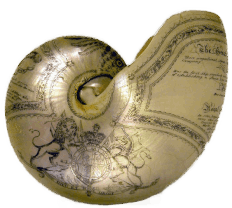

Above, the mammoth tusk cleaned, conserved and mounted.
During the deinstallation of the ‘old’Cole Museum of Zoology at Reading Unversity, this tusk was removed from its display position on the wall by securing it within a sturdy wooden framework before undoing the various brackets that held it in place (Plastazote foam was placed between the wood and the specimen). This wooden frame was also used to transport the specimen to Nigel Larkin’s conservation facility. The tusk was cleaned of dust using gentle compressed air, then was swabbed with cotton swabs dipped in acetone to remove dirt and grime. Areas of old loose and flaking PVA consolidant that had sat on the surface of the tusk for years were removed by dry brushing. Old splatters of paint were removed with fingernails and small wooden toothpicks. A large lump of resin putty and some steel rod was removed from the pulp cavity of the tusk by gentle tapping with small chisels and hammers. This was a remnant of the old armature that had secured the tusk to the wall in the previous gallery. Large longitudinal cracks and smaller cracks in the tusk (which had been open for years) were filled with Japanese tissue paper wetted with neutral pH PVA. This is reversible with the application of a little water if required at a later date. This PVA has passed museum Oddy tests. For more information on the technique see: Larkin, N. R. 2016. Japanese tissue paper and its use in osteological conservation. Journal of Natural Science Collections, Vol 3: 62-67. These gap fills were painted out to match the colour of the surrounding tusk with artists acryllic paints.
A series of upright supports were designed and fabricated to hold the tusk securely in a lifelike orientation. These were manufactured by shaping flat steel to fit the underside of the tusk in each instance and then welding this to an upright rod that in turn was welded to a base plate that had screw holes (for securing to the plinth). These supports were lined with white inert Plastazote foam where they meet the tusk. The plinth was made from MDF cut to size and treated with two coats of Dacrylate clear varnish to reduce off-gassing of VOCs. This plinth and the steel supports were painted to requested colour (light grey) to match the display area.


Above, the mammoth tusk cleaned, conserved and mounted with appropriate humans for scale.
